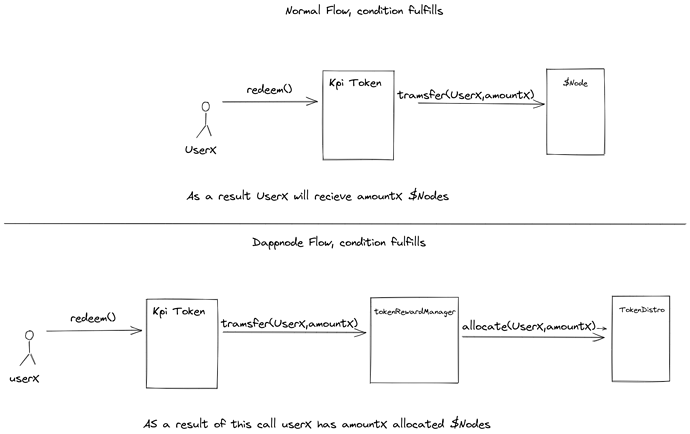Liquidity Mining v2
We need to do better in our Liquidity Mining. We’re throwing $NODE by the buckets and:
- Liquidity is not deep to avoid big price movements
- Nothing keeps people from dumping
Our vesting schedule was innovative at the moment, and the NODEstream has been copied by other projects and our Liquidity Mining was according to the standards at that moment… but things move fast and there are better options.
That’s why I present a different v2:
Carrot.eth
Carrot is a new protocol by DXDAO, aimed exactly at incentivizing the right things efficiently, gradually, and according to goals.
Campaign 1: What will the average TVL for the Swapr xDai NODE-WETH pair be from 2nd March to 27th April (56 days)?
Details
This campaign will pay out in the range of 250K USD to 1M USD, with no payout when the result is below 250K USD and increasing linear payout over the range with a full collateral payout when the result is 1M USD or higher.
Calculating the final answer
The dedicated chart on the official carrot.eth frontend will show daily TVL of the pool in the specified date range. Each bar represents a TVL reading taken each day at 12:00 UTC. To calculate the final result, use the data for each bar and calculate the average between all the charted values.
- Why Swapr? We are speaking with them and have offered to incentivize the farming with SWAPR token too, so NODEstakers would benefit from this incentives too.
Campaign 2: What will the average TVL for the Uniswap v2 or Sushiswap Mainnet NODE-ETH pair be from 2nd March to 27th April (56 days)?
Details
This campaign will pay out in the range of 250K USD to 1M USD, with no payout when the result is below 250K USD and increasing linear payout over the range with a full collateral payout when the result is 1M USD or higher.
Calculating the final answer
The dedicated chart on the official carrot.eth frontend will show daily TVL of the pool in the specified date range. Each bar represents a TVL reading taken each day at 12:00 UTC. To calculate the final result, use the data for each bar and calculate the average between all the charted values.
Campaign 3: Will the average price of NODE from 30th March to 25th May be above 0.4 USD to 1 USD?
Details
This campaign will pay out in the range of 0.4 USD to 1 USD, with no payout when the result is below 0.4 USD and increasing linear payout over the range with a full collateral payout when the result is 1 USD or higher.
Calculating the final answer
The dedicated chart on the official carrot.eth frontend will show price data for NODE in the specified date range. Each data point represents a price reading taken each day at 12:00 UTC. To calculate the final result, use the data for each data point and calculate the average between all the charted values.
I’ve started a calculator to play with the parameters, but I didn’t have time yet to include the reward for the price campaign. Please make a copy and add the Price Campaign reward to the APR numbers and share it with the rest of us! Find it here.
My proposal is to spend 300,000 NODE in every campaign.
900,000 total.
It’s hard to calculate approximates on how much of this would be claimed, but this would give us runway for about a year. Nevertheless, we can always modify the next campaigns!
Also, in order to decide whether we incentivize Uniswap or Sushiswap in mainnet, I suggest to use the one with the deepest pool at the day of deployment, but we can decide in advance!
So:
- Please check the numbers - any counter-proposals? Concerns?
- Uniswap or Sushiswap?
 I’ve lost nearly 1/2 my WETH due to the drop in NODE. I don’t mind taking risks but NODE is VERY risky in its present form.
I’ve lost nearly 1/2 my WETH due to the drop in NODE. I don’t mind taking risks but NODE is VERY risky in its present form.